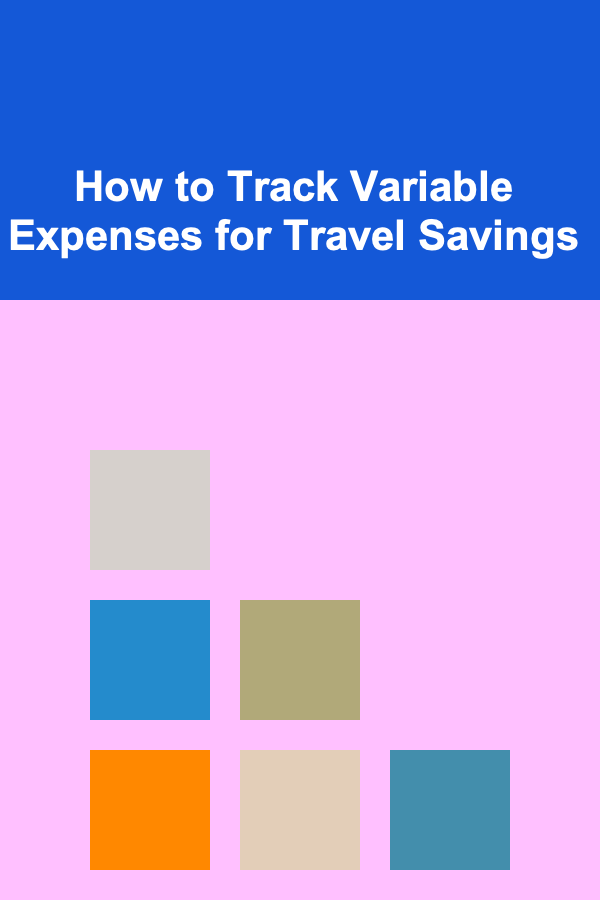
How to Track Variable Expenses for Travel Savings
ebook include PDF & Audio bundle (Micro Guide)
$12.99$10.99
Limited Time Offer! Order within the next:

Travel is one of the most fulfilling experiences in life, but it often comes with a hefty price tag. From flights and accommodation to food and activities, the cost of travel can add up quickly. However, with careful planning, budgeting, and tracking, you can save money on travel expenses and make your dream trips a reality. One of the most important aspects of managing travel finances is understanding and tracking your variable expenses. These are the costs that fluctuate based on your choices, preferences, and situation. Unlike fixed expenses (like rent or car payments), variable expenses can be controlled and adjusted, which makes them an essential area to focus on when saving for travel.
In this article, we'll dive deep into how to track your variable expenses for travel savings, offering actionable tips, strategies, and tools to help you effectively manage your travel budget. Whether you're planning a short weekend getaway or an extended international adventure, mastering variable expenses can be a game-changer for your savings goals.
Understanding Variable Expenses
Before you can effectively track your variable expenses, it's important to understand what they are and why they matter.
What Are Variable Expenses?
Variable expenses are costs that fluctuate from month to month and can vary in amount depending on your lifestyle, decisions, and needs. For travel savings, these expenses are particularly important because they cover a range of categories that directly impact how much you're able to save for your next trip.
Some common examples of variable expenses include:
- Dining out: How often you eat at restaurants, cafes, or order takeout.
- Transportation: Costs related to gas, public transportation, or ride-sharing services (which can vary based on your travel distance and frequency).
- Entertainment: Expenses for movies, concerts, events, or outings.
- Shopping: Purchases for clothing, electronics, or other non-essential items.
- Accommodation: Hotel stays, short-term rentals, or other housing-related expenses when you're traveling.
- Travel-related costs: Things like souvenirs, activities, and excursions during your trip.
By understanding these types of expenses, you can better analyze where your money is going and identify areas where you can cut back to allocate more funds toward your travel savings.
Why Tracking Variable Expenses Is Important for Travel Savings
The reason why tracking variable expenses is so crucial for travel savings is that it allows you to:
- Identify spending patterns: When you track your variable expenses, you gain a clearer picture of your spending habits. This helps you recognize areas where you're overspending and where you could make adjustments.
- Allocate savings more effectively: With a clear understanding of your spending patterns, you can prioritize saving for travel by cutting back on unnecessary expenses or shifting funds from one category to another.
- Make better financial decisions: By monitoring your variable expenses, you can make conscious choices about where to spend and where to save, enabling you to work towards your travel goals more efficiently.
How to Track Your Variable Expenses for Travel Savings
Now that we understand what variable expenses are and why they matter, let's dive into how you can track them effectively. The goal here is to build a system that allows you to monitor your spending and identify opportunities for savings.
1. Set a Travel Savings Goal
Before you can start tracking your variable expenses, it's important to define your travel savings goal. Having a clear target will give you motivation and direction as you track your spending.
Ask yourself:
- What is your desired travel destination?
- How much will the trip cost? Include flights, accommodation, food, activities, and any other travel-related expenses.
- How much time do you have to save for the trip?
- What is your monthly savings goal?
Once you've set your savings goal, break it down into manageable milestones. For example, if you plan to travel in 12 months and your trip will cost $3,000, then you need to save about $250 per month. This goal will give you a target to aim for and help you make decisions about how to reduce your variable expenses.
2. Record Your Expenses Regularly
The next step in tracking your variable expenses is to record them regularly. The more consistent you are in tracking your spending, the better picture you'll have of where your money is going.
You can record your expenses in various ways:
- Manual Tracking: Write down every expense in a notebook or journal. While this method is low-tech, it can be effective for people who prefer a hands-on approach.
- Spreadsheets: Use a program like Excel or Google Sheets to create a detailed budget. Spreadsheets allow you to categorize and track your spending over time, and they can automatically calculate totals and averages for you.
- Expense Tracker Apps: There are many apps available that allow you to track your expenses in real time, automatically categorize transactions, and sync with your bank accounts. Popular apps include Mint, YNAB (You Need a Budget), PocketGuard, and GoodBudget.
3. Categorize Your Variable Expenses
Once you start tracking your expenses, it's important to categorize them. This will help you understand where you're spending most of your money and where you can potentially cut back.
Create categories for each type of expense that you want to track. For example:
- Dining and Food: Restaurants, cafes, groceries, and snacks.
- Transportation: Gas, Uber, Lyft, public transport, and car rental.
- Entertainment and Leisure: Movies, concerts, subscriptions, and other activities.
- Shopping: Clothing, electronics, gadgets, and other non-essential purchases.
You might also consider adding a category specifically for travel-related expenses. This includes things like airline ticket purchases, hotel bookings, and excursions that might be related to your upcoming trip.
4. Analyze Your Spending
Once you've recorded and categorized your expenses for a few weeks or months, it's time to analyze your spending. Look at each category and assess how much you're spending in comparison to your budget.
Ask yourself:
- Are there any categories where you're consistently overspending?
- Are there any non-essential expenses that could be cut or reduced?
- Are there areas where you're not spending enough, such as saving for your travel fund?
When analyzing your spending, it's also important to consider any seasonal or irregular expenses. For instance, you may spend more on dining out during the holidays or in the summer when you're more likely to go on weekend trips. By tracking expenses over a longer period, you'll be able to identify patterns and make adjustments accordingly.
5. Set Spending Limits for Each Category
One of the most effective ways to control your variable expenses is to set limits for each spending category. For example, if you want to save $250 per month for your trip, and you know that dining out is a major variable expense, set a specific budget for eating out each month. If you typically spend $400 on dining out, try to reduce that to $250 by cooking more at home or choosing cheaper dining options.
Use your financial goals and the travel savings target you set earlier to inform these limits. It can also be helpful to set a maximum monthly amount that you want to spend in each category, keeping in mind that there will be times when you need to be more flexible (like during a special event or celebration).
6. Look for Opportunities to Save
After setting limits, you should actively look for ways to save within each category. There are countless ways to reduce your variable expenses without sacrificing your lifestyle. Here are some suggestions:
- Dining Out: Cook at home more often, plan your meals in advance, or choose more affordable restaurants when dining out.
- Transportation: Use public transport instead of taxis, carpool with friends or colleagues, or walk/bike to nearby places.
- Entertainment: Opt for free or low-cost activities such as hiking, visiting museums on free days, or watching movies at home instead of going to theaters.
- Shopping: Avoid impulse purchases, take advantage of sales, and buy second-hand or refurbished items.
- Accommodation: When traveling, consider staying in hostels, guesthouses, or vacation rentals instead of expensive hotels.
By being conscious of these spending habits, you can make small but impactful changes that add up over time, helping you allocate more funds toward your travel savings.
7. Review and Adjust Your Plan Regularly
Tracking your variable expenses isn't a one-time activity. It's essential to review and adjust your budget regularly. Each month, take the time to revisit your spending, evaluate your progress towards your travel savings goal, and make adjustments as necessary. If you notice that you're not hitting your savings targets, try cutting back even more in certain areas.
This ongoing process will help you stay on track and ensure that you're always working towards your travel goals, even if your circumstances change.
Conclusion
Tracking your variable expenses is a crucial step in saving for travel. By understanding your spending patterns, setting limits, and actively seeking opportunities to reduce your expenses, you can free up more money for your travel fund. Whether you use apps, spreadsheets, or manual tracking methods, the key is to be consistent and disciplined in your efforts.
Remember, every dollar you save today is a step closer to your next adventure. By managing your variable expenses and staying committed to your savings goals, you'll be able to turn your travel dreams into reality, all while maintaining financial stability and control. Happy travels!
Reading More From Our Other Websites
- [Star Gazing Tip 101] Star-Gazing Essentials: Gear, Apps, and Tips for Clear Skies
- [Organization Tip 101] How to Create a Personalized Cleaning Supplies Caddy
- [Home Soundproofing 101] How to Manage Indoor Noise Pollution with Home Soundproofing
- [Home Lighting 101] How to Use Lighting to Improve Your Home's Feng Shui
- [Organization Tip 101] How to Plan a Home Renovation Project: Step-by-Step Guide
- [Personal Care Tips 101] How to Build a Sustainable Self-Care for Mental Health Practice That Works for You
- [Biking 101] Top 5 Bike Tools for Easy On-the-Go Repairs
- [Small Business 101] How an E-commerce Platform for Small Business Can Boost Your Online Sales
- [Simple Life Tip 101] Best Strategies for Reducing Screen Time While Staying Connected
- [Organization Tip 101] How to Safely Strip Paint and Varnish from Your Furniture

How to Organize Your Phone and Apps for Better Productivity
Read More
How to Stage Your Living Room to Maximize Space and Comfort
Read More
Why Keeping an Organized Gift Wrapping Station is Handy
Read More
How To Understand the Future of Wireless EV Charging
Read More
How To Choose Your First Electric Vehicle (EV)
Read More
10 Tips for Speed Solving Crosswords: From Beginner to Pro
Read MoreOther Products

How to Organize Your Phone and Apps for Better Productivity
Read More
How to Stage Your Living Room to Maximize Space and Comfort
Read More
Why Keeping an Organized Gift Wrapping Station is Handy
Read More
How To Understand the Future of Wireless EV Charging
Read More
How To Choose Your First Electric Vehicle (EV)
Read More